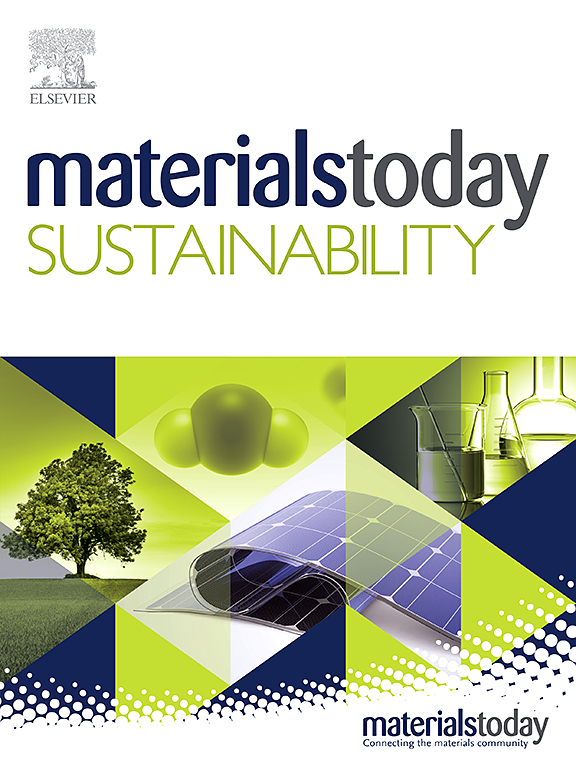Constructing rational pore in nanocarbons by chemical and physical co-activation of polyaniline for high performance electrical double layer capacitors
IF 7.1
3区 材料科学
Q1 GREEN & SUSTAINABLE SCIENCE & TECHNOLOGY
引用次数: 0
Abstract
Rationalizing pore structure of carbon electrode materials is an effective strategy to improve electrochemical performance of electrical double layer capacitors (EDLCs). Herein, chemical-physical co-activation method is developed to prepare polyaniline-derived N-doped porous nanocarbon with useable micropore and small mesopore for guaranteeing high electrostatically adsorptive area and fast ion transport, respectively. K2CO3 firstly pre-activates to create appropriate pores, following by CO2 deep activation for pore development. The resulting coral-like nitrogen-doped porous carbon (NPCKC) exhibits stable nitrogen-doping, largely efficient surface area, reasonable pore configuration (0.7–3 nm), which are highly desirable for capacitive behaviors. When conducted in aqueous electrolyte, NPCKC electrode displays a specific capacitance up to 236 F g−1 at 0.5 A g−1 and conspicuous cyclic stability of 96.9 % retention after 10,000 cycles. More meaningful, the organic NPCKC-based EDLC reaches a 132 F g−1 specific capacitance at 0.2 A g−1 and maintain 120 F g−1 even at 10 A g−1 (90.9 % capacitance retention), greatly surpassing that of commercial AC with similar specific surface area, which exclusively clarifies the significant influence of small mesopores on EDLC energy storage. Meanwhile, it possesses high density energy (40.7 W h kg−1 at 149.6 W kg−1) and power density (23.5 W h kg−1 at 6020 W kg−1), as well as excellent cyclic stability (89.4% of initial capacitance after 10,000 cycles), holding great practical potentials to application in commercial EDLCs.
利用聚苯胺的化学和物理共活化在纳米碳上构建高性能双层电容器的合理孔
优化碳电极材料的孔隙结构是提高双电层电容器电化学性能的有效策略。本文采用化学-物理共活化的方法制备了聚苯胺衍生的n掺杂多孔纳米碳,微孔可用,介孔小,可保证高静电吸附面积和快速离子传输。首先,K2CO3预活化形成合适的孔隙,然后,CO2深层活化孔隙发育。所制得的类珊瑚型氮掺杂多孔碳(NPCKC)具有稳定的氮掺杂、高效的比表面积和合理的孔结构(0.7-3 nm),具有良好的电容性能。当在水溶液中导电时,NPCKC电极在0.5 a g−1时显示出高达236 F g−1的比电容,并且在10,000次循环后保持96.9%的显着循环稳定性。更有意义的是,基于有机npckc的EDLC在0.2 ag−1时达到了132 F g−1的比电容,即使在10 ag−1时也保持了120 F g−1(电容保持率为90.9%),大大超过了具有相似比表面积的商用AC,这完全阐明了小介孔对EDLC储能的重要影响。同时,该材料具有较高的能量密度(在149.6 W kg−1时为40.7 W h kg−1)和功率密度(在6020 W kg−1时为23.5 W h kg−1),以及良好的循环稳定性(循环1万次后为初始电容的89.4%),在商用edlc中具有很大的应用潜力。
本文章由计算机程序翻译,如有差异,请以英文原文为准。
求助全文
约1分钟内获得全文
求助全文
来源期刊

Materials Today Sustainability
Multiple-
CiteScore
5.80
自引率
6.40%
发文量
174
审稿时长
32 days
期刊介绍:
Materials Today Sustainability is a multi-disciplinary journal covering all aspects of sustainability through materials science.
With a rapidly increasing population with growing demands, materials science has emerged as a critical discipline toward protecting of the environment and ensuring the long term survival of future generations.
 求助内容:
求助内容: 应助结果提醒方式:
应助结果提醒方式:


